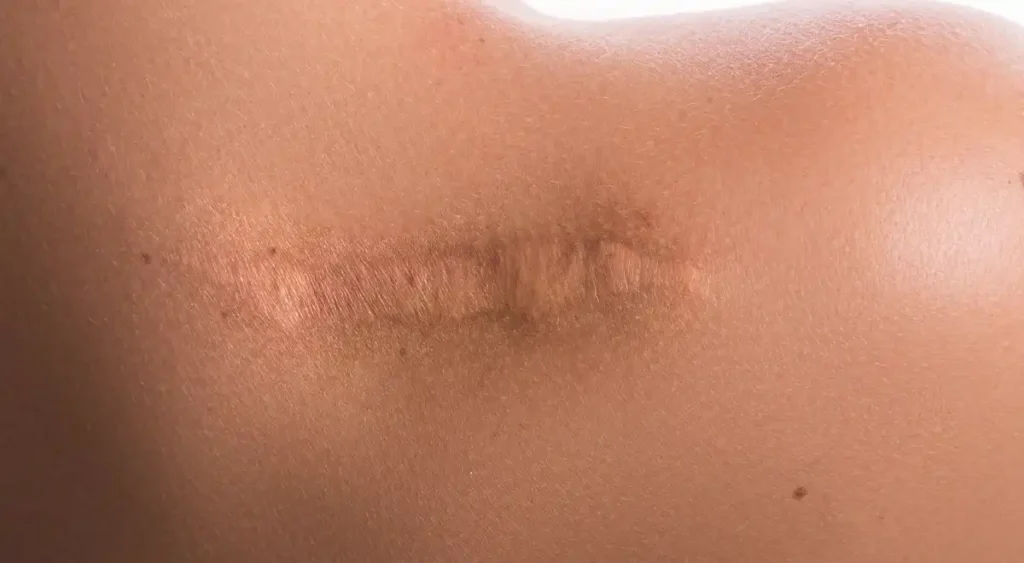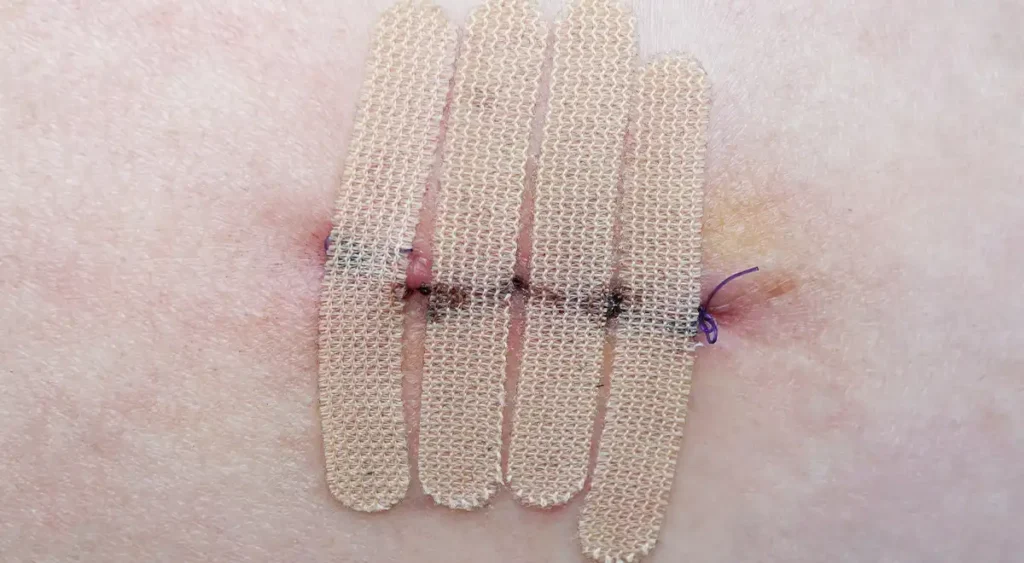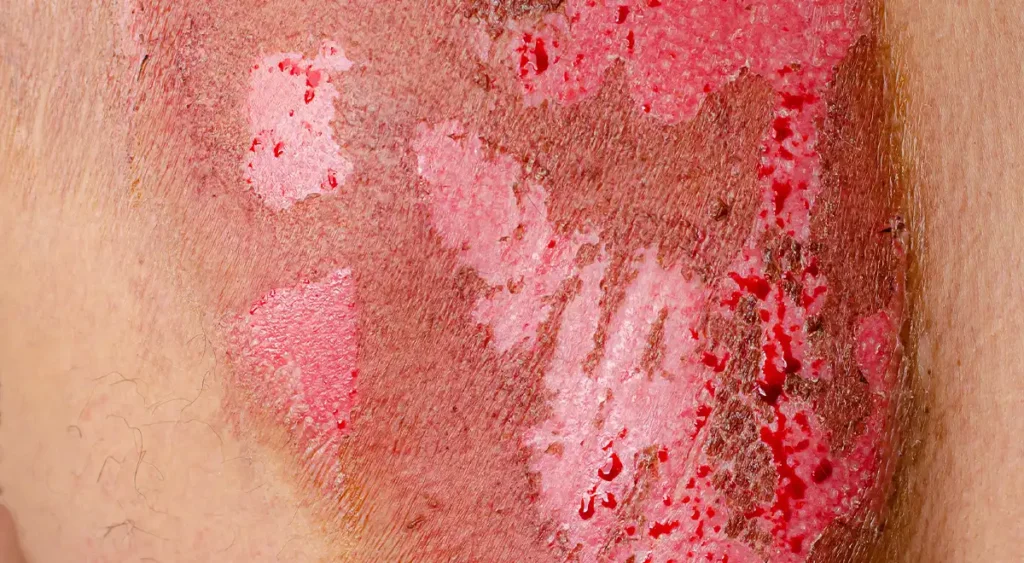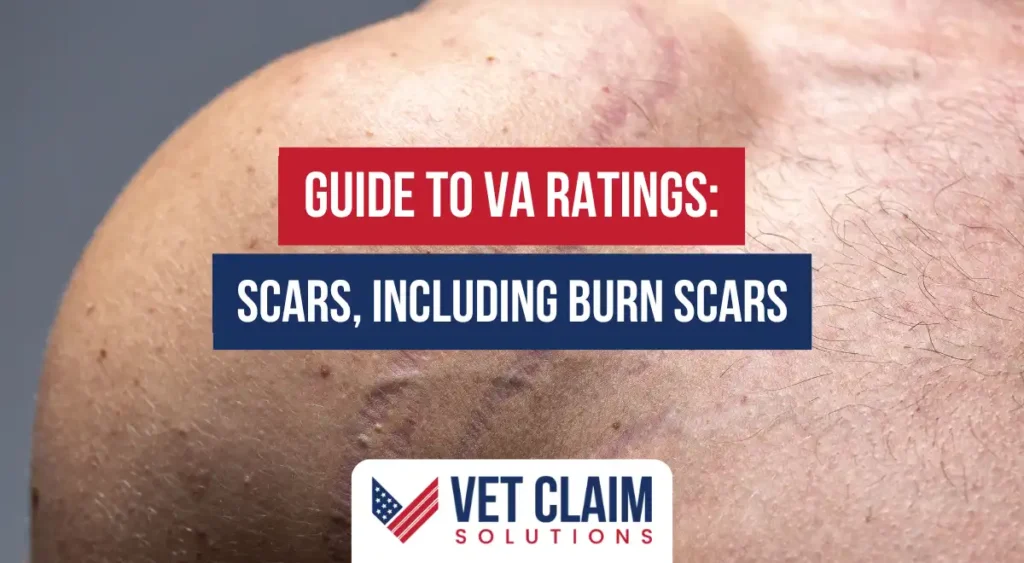Understanding VA Ratings for Scars and Disfigurement (Including Burn Scars) can feel like a puzzle, especially when you are already managing so much. You have served your country, and the marks left behind are often more than just skin deep, telling a story of your experiences. This information aims to provide a clearer picture of how the VA views scars, including challenging ones like burn scars, to help you navigate the va disability claim process. Knowing more about how the VA approaches rating scarring can truly help you get the recognition and va benefits you deserve for your service-related conditions.
What Are Scars and Disfigurement in VA Terms?
So, what exactly does the VA consider a scar? A scar is a mark left on your skin after a wound or injury has healed; it is your body’s natural way of repairing tissue damage. This seems straightforward, but the implications for a va disability rating can vary.
Disfigurement, however, is more involved in the context of va disability claims. It means that a scar or injury has changed your appearance in a more substantial and noticeable way. It might alter the shape of a body part or cause a visible irregularity that affects your underlying soft tissue. The VA pays close attention to disfigurement, especially on the head, face, and neck, because these areas are almost always visible and can have significant social and psychological impacts.
When the VA evaluates scars for a disability rating, they are looking at how these marks affect you. This includes not just your physical appearance but also any chronic pain or functional limitations they might cause, such as those related to soft tissue damage. It is about the overall impact on your well-being and ability to function, which underpins the disability ratings assigned.

Service Connection for Scars
To get a VA rating for your scar, you first need to establish service connection. This means demonstrating that your scar is linked to your military service. There are several ways this connection can be established for your va claim.
The most direct way is if you sustained an injury or burn during your active duty that resulted in a scar; this could stem from a training accident, a combat wound, or another incident that occurred while you were serving. You will need military service records, medical reports, or other evidence showing the event and the treatment you received for the tissue damage. Accurate documentation is very important for proving direct service connection for your disability claim.
Sometimes, scars can appear or worsen due to another condition that is already service-connected, which is known as secondary service connection. For example, if you have a service-connected skin condition that leads to scarring, or if surgery for a service-connected issue like a spinal fusion leaves a scar, that scar may be eligible for a va disability rating. You will have to show how the scar is medically linked to your primary service-connected condition; this might involve providing medical opinions that connect the conditions.
What if you had a small scar before you joined, and your service made it worse? The VA might consider this if your military duties aggravated the pre-existing scar beyond its natural progression. Proving this usually means showing with medical evidence how your service specifically worsened it, demonstrating that the increase in severity was due to service and not just the passage of time. These condition claims require careful documentation.
Veterans dealing with conditions potentially linked to contaminated drinking water at Camp Lejeune should also be aware that some skin conditions leading to scars might be considered for service connection if a link to the exposure can be established through lejeune claims. Filing such camp lejeune claims requires specific evidence related to exposure and resulting health issues.
How the VA Rates Scars and Disfigurement
The VA uses specific rules to decide on a disability rating for scars. These rules are found in the Code of Federal Regulations, Title 38, Section 4.118, under the schedule for skin conditions, utilizing a specific diagnostic code for different types of scars. It is not just about having a scar; it is about how that scar, and any associated tissue loss or underlying soft tissue damage, affects you. The VA looks for what they call “characteristics of disfigurement” to determine the va rate.
Factors such as the size of the scar, its location on your body, and whether it is painful or unstable all play a significant part in the rating scar process. For instance, a scar on your face is generally evaluated differently than a scar on your leg, primarily because facial scars are difficult to conceal and can cause more significant disfigurement. The number of scars, or multiple scars, you have also matters when determining the percent disability.
It is important to understand that not every scar will receive a compensable disability rating. If a scar is very small, superficial, and does not cause any pain or significant disfigurement, it might receive a 0% rating. This 0% rating means the VA acknowledges it as service-connected, but they do not believe it is severe enough for monetary compensation on its own. However, a 0% rating can still be important for accessing VA healthcare for the condition or if the condition worsens in the future.
Key Factors Influencing VA Scar Ratings
Several critical elements come into play when the VA assigns a rating to your scar for a va disability claim. Knowing these can help you understand the basis for your assigned percentage and what to emphasize in your disability claim. Let’s break them down.
Location of the Scar
Where your scar is located is a very important factor for the VA. Scars on the head, face, or neck often receive more attention in the va rating system because they are usually visible and can significantly impact appearance and social interaction. These scars can sometimes lead to secondary conditions like a depressive disorder or generalized anxiety disorder due to their prominent nature.
The VA has specific diagnostic codes for scars based on their location. A disfiguring scar on your face is rated under a different code than a scar on your arm or leg, reflecting how visible disfigurement contributes to the overall disability rating. This distinction highlights the VA’s recognition of the unique impact of facial scarring.
Size and Depth of the Scar
The physical dimensions of your scar, including its total area, also count significantly. The VA will look at how long and wide it is, often measuring in square inches for scars not on the head, face, or neck. For these types of scars, the total area affected by scarring is a key factor in determining the rating.
Depth is also a crucial consideration. A scar that is deep, meaning it extends far into the skin and involves underlying soft tissue damage, might be rated differently than one that is more superficial. Examiners will also note if the scar is raised (hypertrophic) or sunken (atrophic), as these characteristics affect appearance and potential functional limitation.
Permanence of the Scar
The VA considers if your scar is a permanent mark when assigning a disability rating. Most scars are indeed permanent, but some might fade or change over time, especially with specific treatments. The va disability rating is generally based on the current state of the scar and its expected long-term effects on your health and appearance.
If a scar is still healing or if you are undergoing treatment that might significantly alter its appearance, the VA might defer a final rating decision. They prefer to assess the lasting impact once the condition has stabilized to provide an accurate percent disability. This ensures the rating reflects the chronic nature of the scar.

Characteristics of Disfigurement
This is an especially important aspect of understanding VA ratings for scars, particularly for those located on the head, face, or neck. The VA has a list of eight specific “characteristics of disfigurement.” The more of these characteristics your scar exhibits, the higher the potential rating your va disability claim might receive.
These characteristics include factors like the scar’s length and width, its surface texture (whether it is elevated or depressed), and if it adheres to the tissue underneath. Changes in skin color or texture over a defined area, such as more than six square inches, also count, as does demonstrable tissue loss. We will discuss these specific characteristics in more detail later.
Painful or Unstable Scars
Scars do not just affect your appearance; they can also cause significant physical discomfort or chronic pain. If your scar is painful, the VA takes that into account when determining painful scars ratings. You will need to clearly describe the pain – its frequency, severity, duration, and how it impacts your daily life and activities.
An “unstable” scar is one that frequently breaks down, ulcerates, or loses its skin covering, often requiring repeated medical attention. This can occur if the scar tissue is fragile or if it is located in an area prone to friction, pressure, or movement. Painful or unstable scars have their own rating criteria under a specific diagnostic code because they cause ongoing problems and functional impairment.
Focus on Understanding VA Ratings for Scars and Disfigurement (Including Burn Scars)
Burn scars often present distinct and complex challenges compared to other types of scars. Understanding VA Ratings for Scars and Disfigurement (Including Burn Scars) means recognizing how these differ due to the nature of the initial tissue damage and healing process. The impact of a burn can be widespread, severe, and involve significant soft tissue damage.
Specifics of Burn Scars
Burn scars can cover large areas of your body and are often the result of intense heat, chemicals, electricity, or radiation. These scars can cause substantial disfigurement simply due to their size, appearance, and the extent of tissue loss involved. They may also lead to serious functional issues depending on their location and severity.
One common and debilitating problem with burn scars is contractures. This occurs when the new skin and scar tissue become excessively tight, pulling on the surrounding healthy skin and underlying soft tissue. Contractures can severely restrict your range of motion, especially if they occur over joints like your elbows, knees, fingers, or neck. When contractures limit motion, the VA usually rates that limitation of motion itself, often under the diagnostic codes for musculoskeletal conditions, separate from but related to the burn scars.
Extensive burn scars can also affect sweat glands, leading to problems with temperature regulation, and may cause chronic itching or nerve pain. In some very rare instances, a non-healing burn scar could potentially lead to the development of a soft tissue sarcoma, a type of cancer, though this is an exceedingly uncommon complication. Veterans with extensive burn scars might also experience secondary mental health conditions such as major depressive disorder or persistent depressive disorder due to chronic pain and altered appearance.
How Burn Severity Plays a Role
The severity of the original burn (first, second, third, or even fourth-degree) profoundly influences the type and extent of scarring and the potential va rate. Third-degree burns, which destroy the full thickness of the skin and often damage underlying soft tissue, almost always result in significant, permanent scarring. These severe burn scars may require skin grafts and can have a profound, lasting impact on function and appearance.
Second-degree burns can also lead to noticeable scarring, particularly if they are deep partial-thickness burns or cover a large body surface area. Even first-degree burns, though usually healing without significant scars, can sometimes leave lasting pigment changes or altered skin texture. The VA will consider the initial injury documentation, including the degree of the burn and its healing process, when evaluating burn scars for a disability claim.

The VA Rating Percentages for Scars
The VA uses a detailed schedule to assign disability rating percentages for scars, mainly ranging from 0% to 80%. These percentages reflect how seriously the VA views the scar’s impact on your health and daily life. Let’s look at how this generally works, based on VA’s regulations in 38 CFR § 4.118 for rating scarring.
For disfiguring scars on the head, face, or neck (Diagnostic Code 7800), the rating depends on the number of characteristics of disfigurement present, or if there’s tissue loss and gross distortion of facial features. Here’s a general outline:
| Rating | Criteria for Head, Face, or Neck Scars (DC 7800) |
| 10% | One characteristic of disfigurement. |
| 30% | Two or three characteristics of disfigurement, OR noticeable tissue loss and distortion of one facial feature (e.g., eye, nose, mouth). |
| 50% | Four or five characteristics of disfigurement, OR tissue loss and distortion affecting two facial features. |
| 80% | Six or more characteristics of disfigurement, OR tissue loss and gross distortion of three or more facial features. |
What are these “characteristics of disfigurement” the VA looks for? There are eight of them for rating scar severity:
- Scar is 5 inches (13 cm) long or longer.
- Scar is at least one-quarter inch (0.6 cm) wide at its widest point.
- The scar’s surface contour is elevated or depressed when touched.
- The scar is adherent, meaning it’s stuck to the underlying soft tissue.
- Skin color is obviously different (hypopigmented or hyperpigmented) in an area bigger than six square inches (39 sq. cm.).
- Skin texture is abnormal (e.g., shiny, scaly, irregular) in an area bigger than six square inches (39 sq. cm.).
- Soft tissue underneath the scar is missing (tissue loss) in an area bigger than six square inches (39 sq. cm.).
- Skin is hardened and inflexible (indurated) in an area bigger than six square inches (39 sq. cm.).
For scars on other parts of your body (not head, face, or neck), the disability ratings are different. If they are deep and nonlinear (Diagnostic Code 7801), the rating is based on the total area of the scar(s) measured in square inches:
- 10% for a total area of 6 to 11.9 square inches.
- 20% for a total area of 12 to 71.9 square inches.
- 30% for a total area of 72 to 143.9 square inches.
- 40% for a total area of 144 square inches or more.
Superficial, nonlinear scars located elsewhere on the body (Diagnostic Code 7802) that do not cause disfigurement of the head, face, or neck, and are not deep, might receive a 10% rating if they affect a total area of 144 square inches or more.
Painful scars or unstable scars (Diagnostic Code 7804) also have their own specific rating criteria, regardless of location, if not otherwise compensated:
- 10% for one or two such scars.
- 20% for three or four such scars.
- 30% for five or more such scars.
Remember, a scar is “unstable” if it frequently loses its skin covering or ulcerates. If a scar does not meet any of these criteria for a compensable rating (evaluated under Diagnostic Code 7805 for “Scars, other”), it usually gets a 0% percent disability rating. It’s important to note these are general guidelines, and your specific situation and the combined effect of multiple scars will be evaluated by the VA rater. In some cases of severe functional impairment not covered by the schedule, an extra schedular rating might be considered.
The C&P Exam for Scars
If you file a va disability claim for scars, the VA will likely schedule you for a Compensation and Pension (C&P) exam. This examination is a very important part of the process for determining your disability rating. An examiner, usually a doctor or other medical professional contracted by the VA, will look at your scars.
During the exam, they will measure your scars carefully. They will note their precise location, size (often in centimeters or square inches), and appearance, including texture and color. They will specifically check for those eight characteristics of disfigurement we discussed, especially for any scars on your head, face, or neck. Be prepared for them to look closely and potentially touch the scars to assess adherence or contour.
This exam is your opportunity to clearly explain to the examiner how the scars affect you. If they are painful scars, describe the nature of the chronic pain – how often you feel it, how severe it is, what kind of pain it is (e.g., burning, aching, sharp), and how it affects your daily life and ability to perform activities. If they limit your movement, explain how. If they make you feel self-conscious or cause emotional distress, potentially contributing to a panic disorder or anxiety disorder, mention that too. Honesty and clear, specific descriptions help the examiner accurately document your condition for the VA rater, which is crucial for your va disability claims.

Documenting Your Scars for a VA Claim
Good documentation is essential for any va claim, and condition claims for scars are no exception. You need to provide the VA with a clear, comprehensive picture of your scars, how they are connected to your service, and their impact on your life. This helps them make an informed and fair decision on your disability ratings.
Gather your service medical records that show treatment for the original injury or burn that caused the scar. If you received treatment after your military service, include those medical records as well, as they can show the progression of the tissue damage and any ongoing issues. These records can establish when and how the scar occurred and document any resulting tissue loss or need for procedures like spinal fusion if the scar resulted from related surgery.
Photographs can be very useful evidence. Take clear, well-lit pictures of your scars from multiple angles. If possible, include a ruler or measuring tape in some photos to visually demonstrate the size in square inches or length. Also, consider writing a personal statement. In it, you can describe how you got the scar, any pain it causes, how it limits you functionally or socially, or how it affects you emotionally, possibly linking it to issues like sleep apnea if facial scarring impacts breathing, or even aggravating other conditions like rheumatoid arthritis if scars are over joints. Statements from friends, family, or fellow service members who know about your scar and its impact (often called “buddy statements” or lay evidence) can also powerfully support your claim for va benefits. Resources from entities like VA Claims Insider might offer further guidance on preparing your documentation.
What if My Scar Rating is Too Low or Denied?
Sometimes, you might receive a decision from the VA regarding your disability claim that you do not agree with. Perhaps your scar claim was denied, or you believe the disability rating assigned is too low and does not accurately reflect the severity of your condition or the extent of your tissue damage. If this happens, you have options; do not feel like it is the end of the road for your va disability compensation.
The VA has a few different pathways for you to request another review of your claim. You can file a Supplemental Claim if you have new and relevant evidence that was not previously considered by the VA. Alternatively, you could request a Higher-Level Review, where a more experienced senior rater will review the original decision based on the same evidence already in your file. Finally, you can appeal to the Board of Veterans’ Appeals if you disagree with the outcomes of the previous options.
The important first step is to understand why the VA made its decision. The decision letter you receive should explain the reasons for the denial or the specific rating assigned. Reviewing this explanation carefully can help you decide which appeal option is best for your situation and what kind of additional evidence might be needed. It’s also worth noting that if your service-connected scars, possibly in combination with other conditions like traumatic brain injuries or spinal cord injuries, prevent you from maintaining substantially gainful employment, you might be eligible for TDIU benefits (Total Disability based on Individual Unemployability). This allows you to be paid at the 100% disability rate even if your combined schedular rating is less. While scars alone rarely lead to TDIU, severe and extensive scarring, especially burn scars with complications, could be a contributing factor to overall unemployability.
Conclusion
We have covered a lot of ground regarding Understanding VA Ratings for Scars and Disfigurement (Including Burn Scars). It is clear that the VA has a detailed system involving specific diagnostic codes and criteria for evaluating these conditions, from the initial service connection to the final disability rating. While the process for your va claim might seem intricate, knowing how the va rate is determined, what factors like tissue loss or painful scars the VA considers, the importance of square inches in measurements, and what evidence is vital can make a significant difference in your disability claim outcome.
Remember, your scars, including burn scars resulting from your service, tell a part of your unique story, and getting the correct acknowledgment and percent disability from the VA is important for your well-being and access to va benefits. Whether you are just starting your va disability claim journey or considering an appeal, being well-informed about how the VA handles rating scarring and soft tissue damage can empower you to present the strongest possible case. For veterans facing challenges from conditions like gastroesophageal reflux disease, irritable bowel syndrome, or even prostate cancer and Parkinson’s disease, understanding the VA system for one type of claim can provide insights into how other disability claims are processed.


